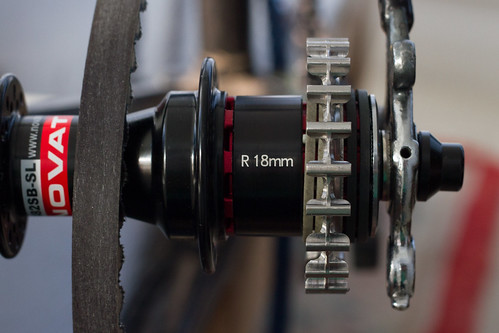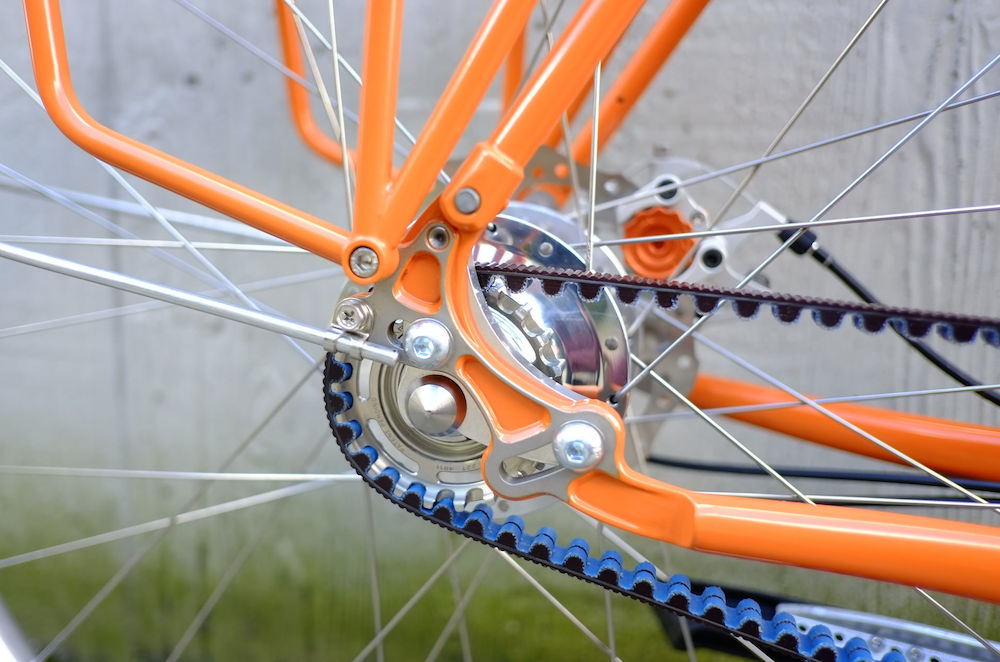Why Ditch the Chain for a Smoother Ride
For cyclists seeking a more efficient, low-maintenance, and quieter ride, a bicycle belt drive kit is an attractive alternative to traditional chain drives. By replacing the chain with a durable, toothed belt, riders can experience a significant reduction in friction and vibration, resulting in a smoother, more enjoyable ride. The benefits of belt drive conversion are numerous, including reduced wear and tear on components, increased power transfer, and a substantial decrease in noise pollution. With a belt drive kit, cyclists can focus on the road ahead, rather than worrying about the mechanical nuances of their bike. Whether commuting to work, tackling rugged terrain, or simply enjoying a leisurely ride, a belt drive system can elevate the overall cycling experience.
How to Choose the Right Belt Drive Kit for Your Bike
Selecting the perfect bicycle belt drive kit can be a daunting task, especially with the numerous options available in the market. However, by considering a few key factors, cyclists can ensure a seamless and efficient ride. The type of bike, riding style, and terrain are crucial factors to consider when choosing a belt drive kit. For instance, commuters may prefer a kit with a durable belt and robust pulleys, while mountain bikers may opt for a kit with a lightweight belt and adjustable tensioners. Popular brands like Gates Carbon Drive and Shimano offer a range of belt drive kits catering to different cycling needs. When selecting a kit, it’s essential to consider the compatibility of the components with the bike’s frame and gear system. Additionally, cyclists should research the warranty and customer support offered by the manufacturer. By taking these factors into account, cyclists can find the ideal bicycle belt drive kit that meets their specific requirements and enhances their overall cycling experience.
The Anatomy of a Belt Drive System: Understanding the Components
A bicycle belt drive kit consists of three primary components: the belt, pulleys, and tensioners. Understanding how each part works together is crucial to appreciating the benefits of a belt drive system. The belt, typically made of a durable, toothed material, is the backbone of the system, providing a smooth and efficient transfer of power. The pulleys, which come in various sizes and shapes, guide the belt and maintain its alignment. Tensioners, which can be either manual or automatic, ensure the belt is properly tightened, preventing slippage and wear. When these components work in harmony, they provide a ride that is not only smoother but also more efficient, with reduced energy loss and increased power transfer. By grasping the intricacies of a belt drive system, cyclists can better appreciate the advantages of a bicycle belt drive kit and make informed decisions when selecting a kit for their bike.
Converting Your Bike: A Step-by-Step Guide to Belt Drive Installation
Installing a bicycle belt drive kit may seem daunting, but with the right guidance, it can be a straightforward process. Before starting, ensure you have the necessary tools and a clean workspace. Begin by removing the old chainring and chain, taking note of the gear configuration and any specific requirements for your bike. Next, measure and mark the correct position for the belt drive pulleys, ensuring proper alignment and clearance. Install the pulleys, followed by the belt, making sure it is properly seated and tensioned. Adjust the tensioners according to the manufacturer’s instructions, and test the system to ensure smooth operation. Finally, fine-tune the belt drive kit by adjusting the derailleurs and shifters to optimize performance. With patience and attention to detail, cyclists can successfully convert their bike to a belt drive system, enjoying the benefits of a quieter, more efficient ride. When selecting a bicycle belt drive kit, consider factors such as compatibility, durability, and ease of installation to ensure a seamless conversion process.
Troubleshooting Common Issues with Belt Drive Systems
While a bicycle belt drive kit can provide a smoother and more efficient ride, it’s not immune to occasional issues. Identifying and addressing these problems promptly can ensure a seamless cycling experience. Here are some common problems that may arise with belt drive systems and their solutions:
Belt Wear: Over time, the belt may show signs of wear, such as cracks, frays, or excessive stretching. To prevent this, regularly inspect the belt for damage and replace it every 3,000 to 5,000 miles or as recommended by the manufacturer. Proper belt tension and alignment can also help extend its lifespan.
Pulley Misalignment: Misaligned pulleys can cause the belt to wear unevenly, leading to premature failure. To avoid this, ensure that the pulleys are properly aligned during installation and periodically check their alignment during maintenance.
Tensioner Issues: A malfunctioning tensioner can cause the belt to become too loose or too tight, affecting the overall performance of the belt drive system. Regularly inspect the tensioner for signs of wear or damage and replace it if necessary.
Noise and Vibration: Unusual noises or vibrations can indicate a problem with the belt drive system. Check the belt and pulleys for proper alignment and tension, and ensure that all components are securely fastened.
By being aware of these common issues and taking proactive steps to address them, cyclists can enjoy a trouble-free ride with their bicycle belt drive kit. Regular maintenance and inspections can help prevent problems from arising in the first place, ensuring a smooth and efficient ride for miles to come.
Belt Drive vs. Chain Drive: Which is Right for You?
When it comes to choosing the right drivetrain for your bicycle, the debate between belt drive and chain drive systems has been ongoing for years. Both options have their advantages and disadvantages, and understanding the differences between them is crucial in making an informed decision. In this section, we’ll delve into the pros and cons of each system, helping you determine which one is best suited for your cycling needs.
Chain drive systems have been the traditional choice for bicycles, offering a reliable and efficient way to transfer power from the pedals to the wheels. However, they require regular maintenance, such as lubricating and cleaning the chain, to ensure optimal performance. Chain drives are also prone to wear and tear, which can lead to rust and corrosion over time.
Belt drive systems, on the other hand, offer a smoother and quieter ride, with reduced maintenance requirements. A bicycle belt drive kit eliminates the need for lubrication and cleaning, making it an attractive option for commuters and urban cyclists. Belt drives are also more resistant to wear and tear, providing a longer lifespan compared to chain drives.
One of the primary advantages of belt drive systems is their ability to provide a consistent and smooth power transfer. This is particularly beneficial for riders who frequent rough terrain or encounter frequent stops and starts. Additionally, belt drives are less prone to skipping or slipping, ensuring a more efficient ride.
However, belt drive systems are not without their limitations. They can be more expensive than traditional chain drives, and may require specific frame designs or modifications to accommodate the belt. Furthermore, belt drives may not be suitable for high-performance or competitive cycling, where the added weight and reduced power transfer may be a disadvantage.
In conclusion, the choice between a belt drive and chain drive system ultimately depends on your cycling style, terrain, and personal preferences. If you prioritize a smooth and quiet ride with reduced maintenance, a bicycle belt drive kit may be the ideal choice. However, if you’re a competitive cyclist or require the highest level of power transfer, a traditional chain drive may be the better option.
Real-World Examples: Bicycles That Benefit from Belt Drive Conversion
When it comes to upgrading to a bicycle belt drive kit, various types of bicycles can reap the benefits of a smoother, quieter ride. From daily commutes to off-road adventures, belt drive systems can enhance the overall cycling experience. Here are some real-world examples of bicycles that can benefit from a belt drive conversion:
Commuter Bikes: For urban riders, a belt drive kit can be a game-changer. With reduced maintenance and increased efficiency, commuters can enjoy a hassle-free ride to work or school. The Gates Carbon Drive system, for instance, is a popular choice for commuter bikes, providing a clean and quiet ride in any weather condition.
Mountain Bikes: For mountain bikers, a belt drive kit can offer improved durability and reduced wear on components. The absence of a chain reduces the risk of chain breaks and dropped chains, allowing riders to focus on the trail ahead. Shimano’s belt drive system, designed specifically for mountain bikes, provides a reliable and efficient ride in challenging terrain.
Road Bikes: Road cyclists can also benefit from a belt drive conversion, particularly those who prioritize speed and efficiency. A belt drive kit can reduce energy loss and provide a smoother ride, allowing riders to maintain high speeds for longer periods. With brands like Gates Carbon Drive offering belt drive kits specifically designed for road bikes, riders can experience the thrill of a chain-free ride.
Electric Bikes: Electric bicycles can also benefit from a belt drive conversion, as it can improve the overall efficiency of the motor and reduce wear on components. A belt drive kit can provide a quieter ride and reduce the risk of chain breaks, making it an attractive option for e-bike owners.
In each of these scenarios, a bicycle belt drive kit can provide a range of benefits that enhance the cycling experience. By understanding the specific advantages of belt drive systems for different types of bicycles, riders can make an informed decision about upgrading their ride.
Conclusion: Take Your Cycling to the Next Level with a Belt Drive Kit
In conclusion, upgrading to a bicycle belt drive kit can revolutionize the cycling experience. With reduced maintenance, increased efficiency, and a quieter ride, belt drive systems offer a range of benefits that can enhance any ride. Whether you’re a daily commuter, an avid mountain biker, or a road cycling enthusiast, a belt drive kit can provide a smoother, more enjoyable ride.
By understanding the components of a belt drive system, selecting the right kit for your bike, and following a step-by-step installation guide, riders can easily make the switch to a belt drive. Additionally, troubleshooting common issues and comparing belt drive systems with traditional chain drives can help riders make an informed decision about upgrading their ride.
As the cycling industry continues to evolve, belt drive technology is poised to play a significant role in shaping the future of cycling. With ongoing innovations and advancements in belt drive systems, riders can expect even more efficient, durable, and high-performance options in the years to come.
So why wait? Take your cycling to the next level with a bicycle belt drive kit. Experience the thrill of a smoother, quieter ride, and discover the benefits of belt drive technology for yourself. With a wide range of options available, there’s never been a better time to upgrade your ride and enjoy the ultimate cycling experience.






